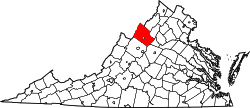Singers Glen | |
|---|---|
 Singers Glen welcome sign | |
| Nickname: "Birthplace of Sacred Music in the South" | |
 Location of the Singers Glen CDP within the Rockingham County | |
| Coordinates: 38°33′0″N78°54′51″W / 38.55000°N 78.91417°W | |
| Country | |
| State | Virginia |
| County | Rockingham |
| Elevation | 500 m (1,600 ft) |
| FIPS code | 51-72736 |
| GNIS feature ID | 2807442 |
Singers Glen is a census-designated place (CDP) located in Rockingham County, Virginia, United States, and situated between Little North Mountain and Interstate 81. Singers Glen is a historic settlement that is registered by both the Virginia Historic Landmarks Commission and the United States Department of the Interior. [1] The community comprises one road (Singers Glen Road), the Singers Glen Post Office, a recycling center, the Singers Glen School, the Singers Glen Volunteer Fire Company, Singers Glen volunteer rescue squad, one store, and a Methodist and Baptist Church. It is listed as a CDP for the United States Census 2020.


